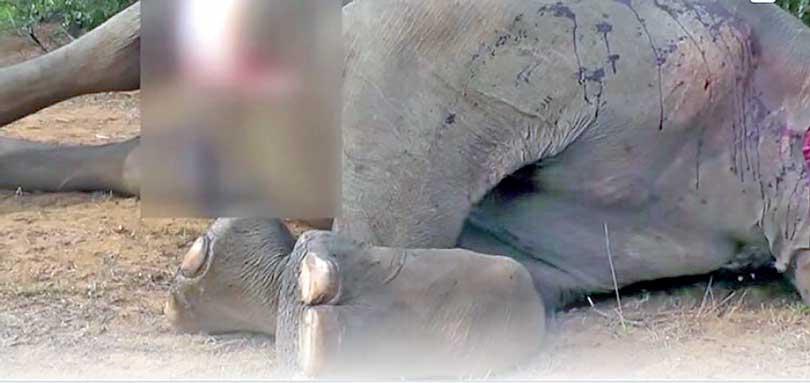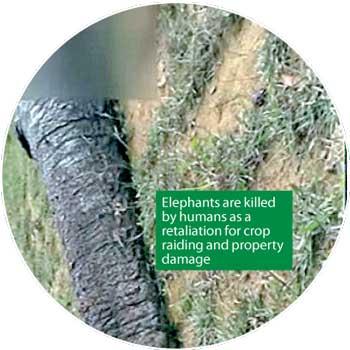Reply To:
Name - Reply Comment

Dismembered body of the recently killed tusker at Yala Block III
 Sri Lanka lost approximately 460 elephants in 2019 mainly as a result of the Human-Elephant Conflict. Besides that, deliberate attempts of ivory poaching have been reported from time to time. With every passing World Animal Day, that falls on October 4, more wildlife, flora and fauna are threatened by anthropogenic events. Recent footage of a dismembered tusker at Yala Block III has once again raised concerns on ivory poaching in Sri Lanka. The pandemic situation is a blessing for criminals to execute petty operations in the wild as many DWC officers are either on leave or are in quarantine. On the other hand, elephant experts opine that for 70 years Sri Lanka hasn’t been able to develop a conceptual model to protect elephants.
Sri Lanka lost approximately 460 elephants in 2019 mainly as a result of the Human-Elephant Conflict. Besides that, deliberate attempts of ivory poaching have been reported from time to time. With every passing World Animal Day, that falls on October 4, more wildlife, flora and fauna are threatened by anthropogenic events. Recent footage of a dismembered tusker at Yala Block III has once again raised concerns on ivory poaching in Sri Lanka. The pandemic situation is a blessing for criminals to execute petty operations in the wild as many DWC officers are either on leave or are in quarantine. On the other hand, elephant experts opine that for 70 years Sri Lanka hasn’t been able to develop a conceptual model to protect elephants.
Operation continues
 “We received information regarding the incident during the morning hours on August 15, 2021,” recalled Uva Wildlife Zone Deputy Director-in-Charge W. A Indrajith. “Thereafter I sought assistance from Police and they deployed sniffer dogs to the location. But we couldn’t find any leads on that day. But the following day the person, who owned the shotgun, used for killing the elephant, was identified by intelligence officers. Thereafter we received information about the second suspect and was informed that the two tusks and the tail were dumped at a nearby location. We produced these items to the Police and have received a court order to conduct DNA sampling to see if these specimen belong to the elephant.
“We received information regarding the incident during the morning hours on August 15, 2021,” recalled Uva Wildlife Zone Deputy Director-in-Charge W. A Indrajith. “Thereafter I sought assistance from Police and they deployed sniffer dogs to the location. But we couldn’t find any leads on that day. But the following day the person, who owned the shotgun, used for killing the elephant, was identified by intelligence officers. Thereafter we received information about the second suspect and was informed that the two tusks and the tail were dumped at a nearby location. We produced these items to the Police and have received a court order to conduct DNA sampling to see if these specimen belong to the elephant.
“But for the first time in history we were able to nab suspects within three days as a result of the assistance I received from the authorities including the Wildlife Minister. Charges have been filed against the two suspects under the Public Property Act and the Flora and Fauna Protection Ordinance and they were remanded till September 1. But with several police officers going on quarantine their remand period has extended. However, the third suspect is still missing and we have launched an operation to locate him,” Indrajith added.
He said that a part of the elephant’s skull is missing as it had been dismembered and therefore it would be difficult to fit the tusks into the elephant’s skull and see if they fit. “The two tusks could be overlapping, separated sideways or could be projected downwards,” he said.
An incident of ivory poaching
However, apart from a few incidents elephant experts claim that a majority of elephants in Sri Lanka are killed due to the Human-Elephant Conflict. “Several tuskers have been killed during the past 4-5 years in Sri Lanka. From what I can recall, except for 2 tuskers that were found without their tusks, the others were found dead with their tusks intact,” opined Conservationist and former DWC Director General Dr. Sumith Pilapitiya. “If the motive of killing the tuskers was ivory poaching then the tusks would be removed from the elephants upon death, similar to the elephant that was butchered in Yala a few days ago. If tuskers are killed and the tusks are still intact when the bodies are found that means that the tuskers have been killed because of the human elephant conflict or more precisely due to retaliation for crop raiding and not for ivory poaching.“The Galgamuwa tusker for instance had its tusks intact when the body was found, so the Galgamuwa tusker is most likely a victim of the human elephant conflict, whereas the elephant found recently in Yala appears to have been poached for it’s ivory. Based on the data of killed tuskers a majority have had their tusks intact, so we can conclude that they were not killed for their ivory. In my opinion, ivory poaching is not as serious a problem yet in Sri Lanka. Although we should make sure not to lose even one tusker either to the conflict or ivory poaching,” he added.
When asked about legal provisions Dr. Pilapitiya said that the Fauna and Flora Protection Ordinance (FFPO) has given quite a lot of attention to the protection of elephants. “In fact, Part II of the FFPO is entirely devoted to the protection of elephants. There are provisions under Part II of the FFPO which make it illegal to own or possess a tusk or tush without proper registration and against killing or injuring an elephant. While penalties such as fines and/or terms of imprisonment are prescribed in the FFPO, I believe the penalties are not high enough to be a deterrent. So we need to revise these penalties to be an effective deterrent to killing or injuring an elephant including for the possession of illegal tusks or tushes. In addition to provisions under the FFPO being available for prosecution, offences against elephants can be prosecuted under the Offences against Public Property Act and any offence committed under the Act involving an elephant shall be a non-bailable offence under the Bail Act and the Code of Criminal Procedure Act. So there is adequate legislation, but it could be improved by increasing the penalties to be an effective deterrent.” he said.
For the first time in history we were able to nab suspects within three days as a result of the assistance I received from the authorities including the Wildlife Minister. Charges have been filed against the two suspects under the Public Property Act and the Flora and Fauna Protection Ordinance”
- W. A Indrajith Uva Wildlife Zone Deputy Director-in-Charge
All or None theory
Responding to a query on approaches that could be implemented to minimise these kinds of incidents he said that measures such as radio collaring elephants to give real-time information to prevent confrontation and conflict are not a practical solution. “Radio collars are used generally to determine elephant range; basically to guide management decisions. Measures that we can take to mitigate the human elephant conflict are what needs to be taken urgently to minimize elephants from getting killed. I have heard some people calling for the tuskers to be protected, but how do we protect only the tuskers in the wild? A certain wildlife minister ordered DWC staff to protect a tusker who was coming to a garbage dump to escape from possible poachers, a few years ago. But this is not a practical proposition. Though the DWC staff were with the elephant who was at the garbage dump there was no practical way to follow the tusker when he was in the jungle, 24 hours a day. Also can we assign DWC staff to follow all tuskers in Sri Lanka, 24 hours a day, 7 days a week, 365 days a year, throughout the tusker’s lifetime? That is nonsense. The only practical way to protect tuskers in the wild is to protect ALL elephants in the wild and tuskers will automatically get protected. For that we have to have effective Human Elephant Conflict (HEC) mitigation,” he explained.
Adequacy of Govt. strategies
The incumbent Government recently arrived at a decision to increase compensation for people who are victimised by the HEC. “Increasing compensations for the victims of human elephant conflict is a good short-term measure,” he continued. “Compensation address a symptom of the HEC problem, but it is by no means a solution. But on the longer-term the Government should be looking at effective ways of minimising HEC. We have been unable to provide effective HEC mitigation because the conceptual model used in HEC mitigation in Sri Lanka is flawed. I am making this statement based on scientific facts and this is not voicing an opinion. The conceptual model used in Sri Lanka for HEC mitigation is based on a Master Plan prepared in 1949 and this model proposes to restrict elephants to DWC protected areas. We have been trying to do this for the past 70 years-by driving elephants into DWC protected areas and erecting electric fences to contain them within the DWC protected areas. 4500 km of fencing has been constructed at present, but the conflict keeps increasing every year. Elephant distribution data collected by the Center for Conservation and Research (CCR), based on surveys conducted throughout Sri Lanka, show that 44% of the land area outside DWC protected areas (PAs) have elephants, with humans and elephants sharing the same landscape. Since we have tried for 70 years to limit elephants to DWC PAs and the result is that we have elephants in 44% of the land area of Sri Lanka, outside the DWC PA network, there obviously is a problem with the conceptual model we are using.” said Dr. Pilapitiya.
 Compensation address a symptom of the HEC problem, but it is by no means a solution. But on the longer-term the Government should be looking at effective ways of minimising HEC. We have been unable to provide effective HEC mitigation because the conceptual model used in HEC mitigation in Sri Lanka is flawed. I am making this statement based on scientific facts and this is not voicing an opinion
Compensation address a symptom of the HEC problem, but it is by no means a solution. But on the longer-term the Government should be looking at effective ways of minimising HEC. We have been unable to provide effective HEC mitigation because the conceptual model used in HEC mitigation in Sri Lanka is flawed. I am making this statement based on scientific facts and this is not voicing an opinion
-Dr. Sumith Pilapitiya Conservationist and former DWC Director General
He further said that elephants cannot be confined to DWC PAs because of biological reasons or requirements of elephants. “But the political authorities of successive governments have been trying to use different physical barriers to confine elephants to DWC PAs without addressing the fundamental biological requirements of elephants. After 70 years of trying we must realise that this has been a failure because there are elephants in 44% of the land area of Sri Lanka—outside the DWC PA network. If for 70 years we have been unable to confine elephants to DWC PAs, don’t you think it is time for us to look for a better conceptual model? So unless we have a paradigm shift in the way we approach HEC mitigation and start understanding the biological needs of elephants and take that into account, the human and elephant casualties will increase annually as has been the case over the last few decades. Elephants are killed by humans as a retaliation for crop raiding and property damage. So if we are able to protect crops and property, the need to kill elephants will not arise. Electric fences are still the most effective deterrent. But the fences should be on the boundary of what we want protected. Community based fencing on the periphery of villages and seasonal agricultural fences around agriculture has been pilot tested by the Center for Conservation and Research (CCR) for over 10 years in about 50 villages and 30 paddy tracts. The community based fences have been very effective in protecting people, property and crops. Very few elephants have been killed in the areas pilot testing community based fences because elephants have been prevented from raiding paddy fields. Therefore, if we need to mitigate HEC and minimize the killing of all elephants, including tuskers, we need to learn from successful community based models rather than investing more public funds on tried, tested and failed solutions.” he said.
STF troops patrolling the wild- minister
 Commenting on the issue Minister of Wildlife and Forest Conservation Minister C. B Rathnayaka said that Special Task Force troops have been deployed in all national parks, forests, protected areas so as to identify any suspicious activity. “We took swift action to nab suspects the moment we received information about the elephant. STF troops have been deployed in an attempt to ensure that there are no illegal activities taking place in protected areas and to protect every species in the wild. So far seven troops have been deployed for this task.” the Minister said.
Commenting on the issue Minister of Wildlife and Forest Conservation Minister C. B Rathnayaka said that Special Task Force troops have been deployed in all national parks, forests, protected areas so as to identify any suspicious activity. “We took swift action to nab suspects the moment we received information about the elephant. STF troops have been deployed in an attempt to ensure that there are no illegal activities taking place in protected areas and to protect every species in the wild. So far seven troops have been deployed for this task.” the Minister said.